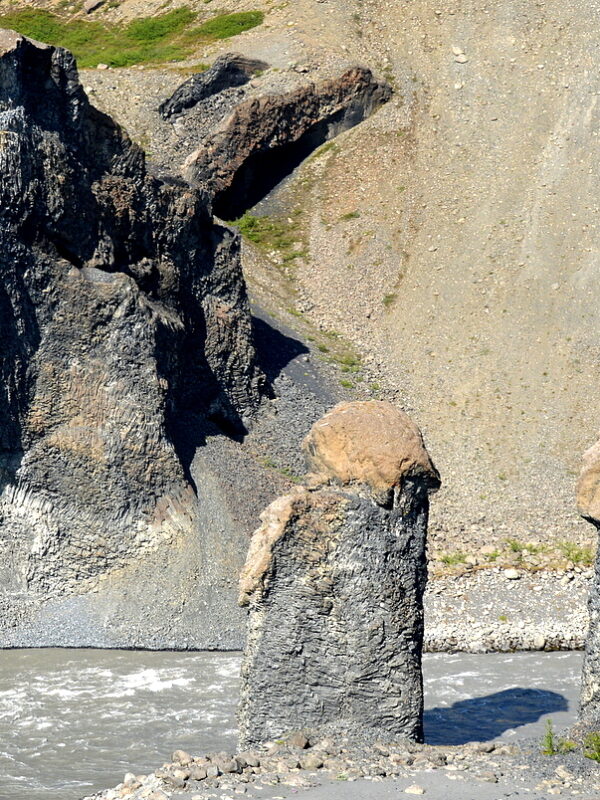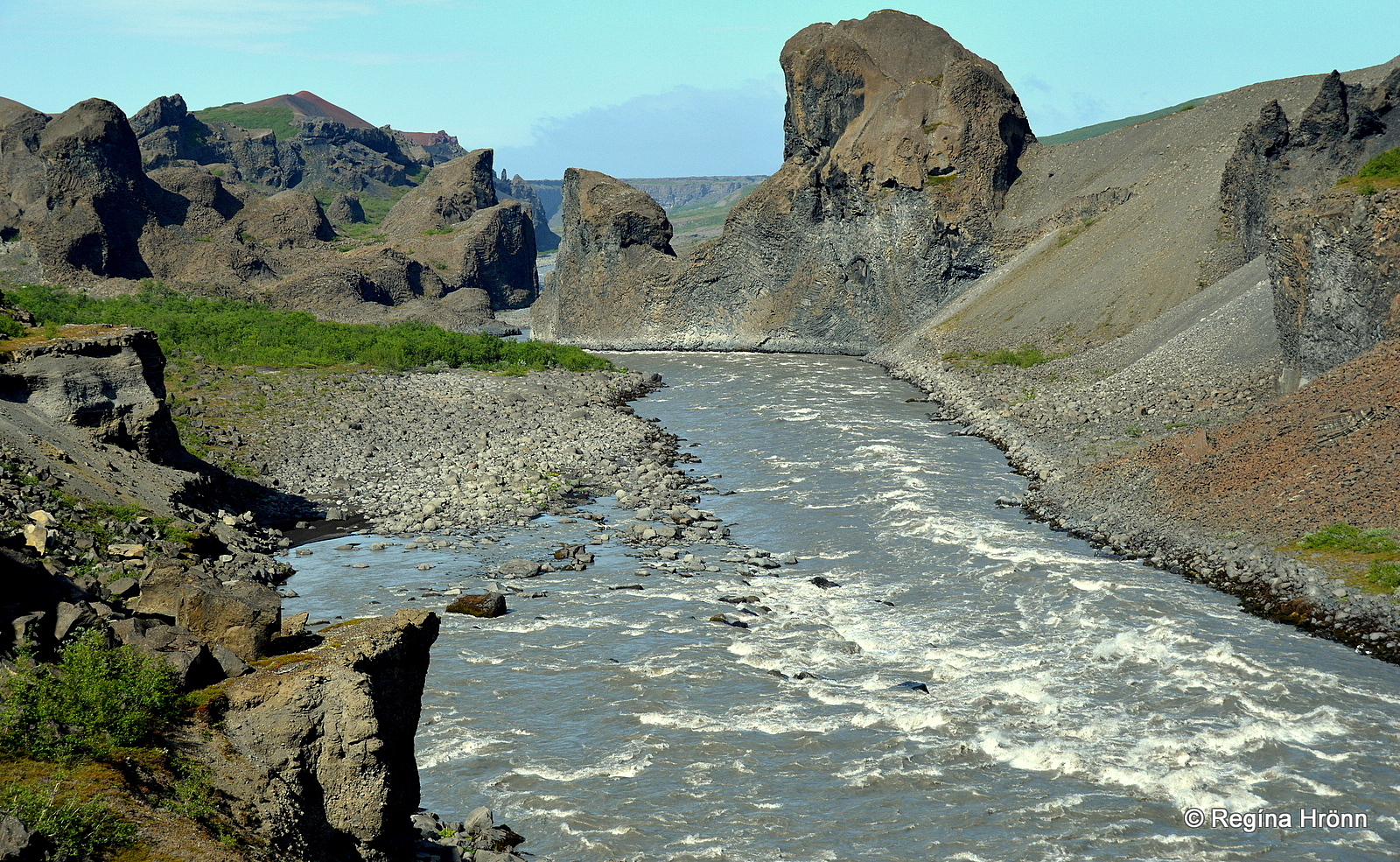
Hljóðaklettar and Jökulsá á Fjöllum glacial river in Jökulsárgljúfur canyon
These extraordinary rock formations, some of them standing in the middle of Jökulsá á Fjöllum glacial river, are the remains of an ancient row of craters that have been eroded for centuries after centuries by the strong currents and floods of the river.
Rauðhólar scoria cone and Hljóðaklettar are a part of a long row of craters, which erupted approximately 9,000 years ago.
Only the volcanic plugs are now remaining, but a catastrophic flood in the glacial river 2,500-3,000 years washed the volcanic material away.
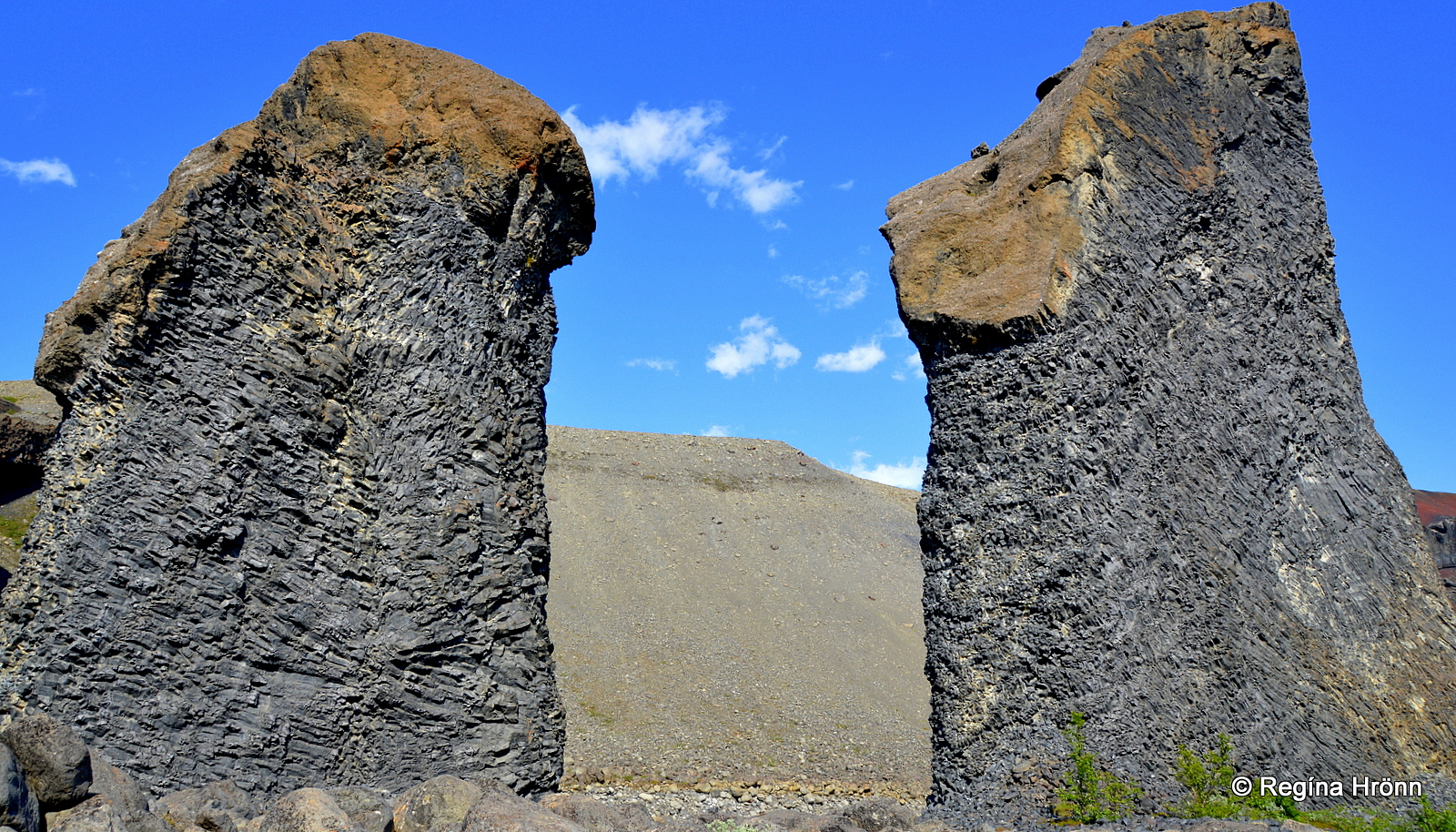
Two trolls in Hljóðaklettar – Karl and Kerling
The turbulent glacial river Jökulsá á Fjöllum, the second-longest river in Iceland, on its way from Vatnajökull glacier, Iceland’s largest glacier and Europe’s largest ice cap by volume, runs through the 25 km long Jökulsárgljúfur canyon.
The name of this magnificent canyon means Glacial River Canyon.
On its way through this magnificent canyon, the glacial river passes Hljóðaklettar – the Echo Rocks. The name Echo Rocks derives from the sounds – echo of the roaring glacial river.
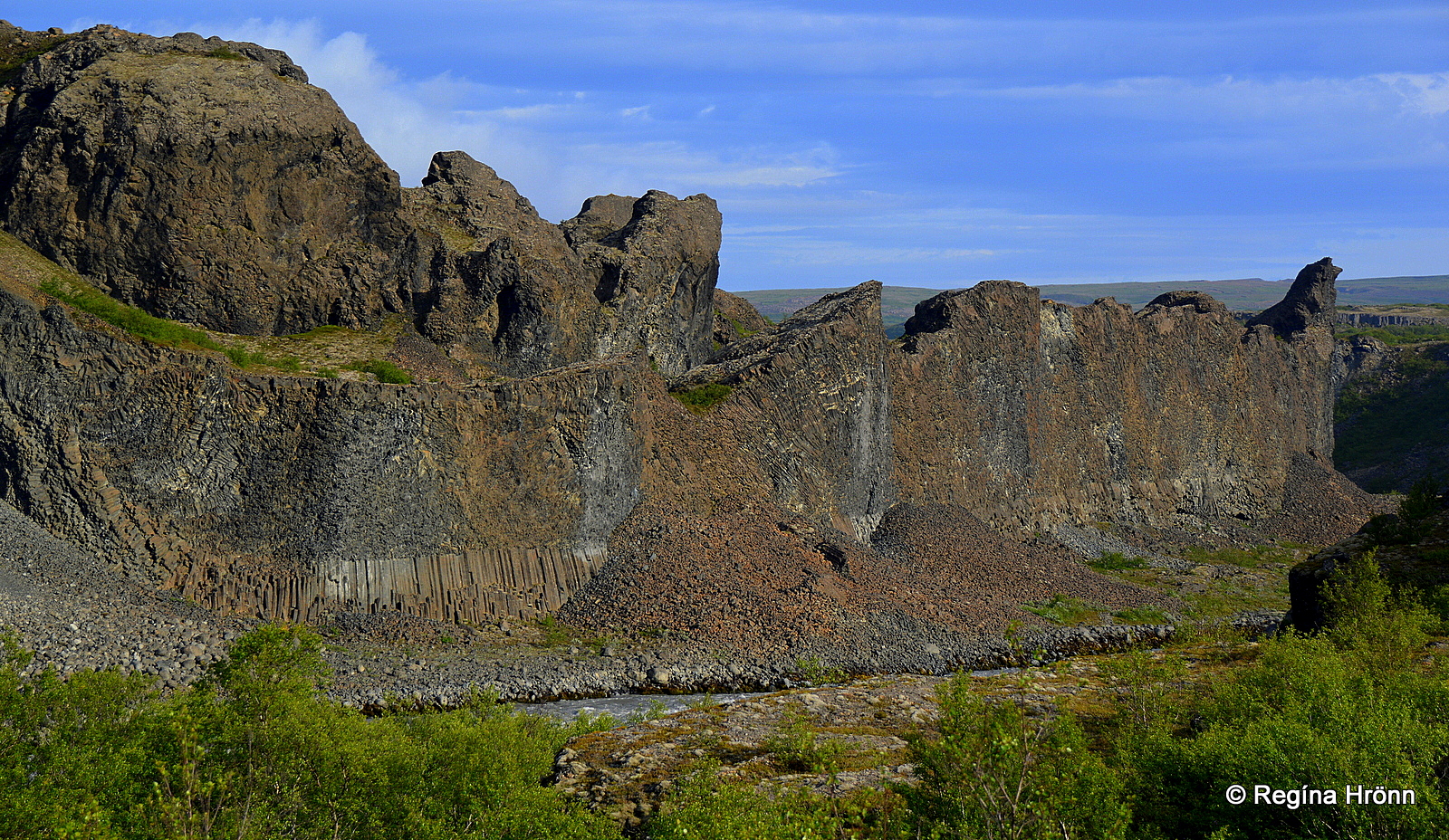
At Hljóðaklettar in Jökulsárgljúfur canyon
When standing in certain spots in Hljóðaklettar the sounds of the river are magnified by the rocks and if you close your eyes you might not know from which direction the sounds of the glacial river actually comes.
Further south in Jökulsárgljúfur canyon the river, the glacial river cascades into the canyon creating 4 extraordinary waterfalls, amongst them the most powerful waterfall in Iceland, Dettifoss waterfall, as I showed you in my previous travel-blog:
The Massive Dettifoss Waterfall in Jökulsárgljúfur Canyon in North-Iceland

Visiting Dettifoss waterfall in Jökulsárgljúfur canyon
A short hike from the parking lot in Hljóðaklettar will take you to the cluster of rocks in Hljóðaklettar, which is a labyrinth of volcanic plugs with many caves and extraordinary basalt columns formations.
Some of the rock formations in Hljóðaklettar have been given names, like Kastalinn – the Castle, Kirkjan – the Church, Skuggi – the Shadow and Tröllið – the Troll, all on the west side of the glacial river.
Tröllið – the Troll in Hljóðaklettar
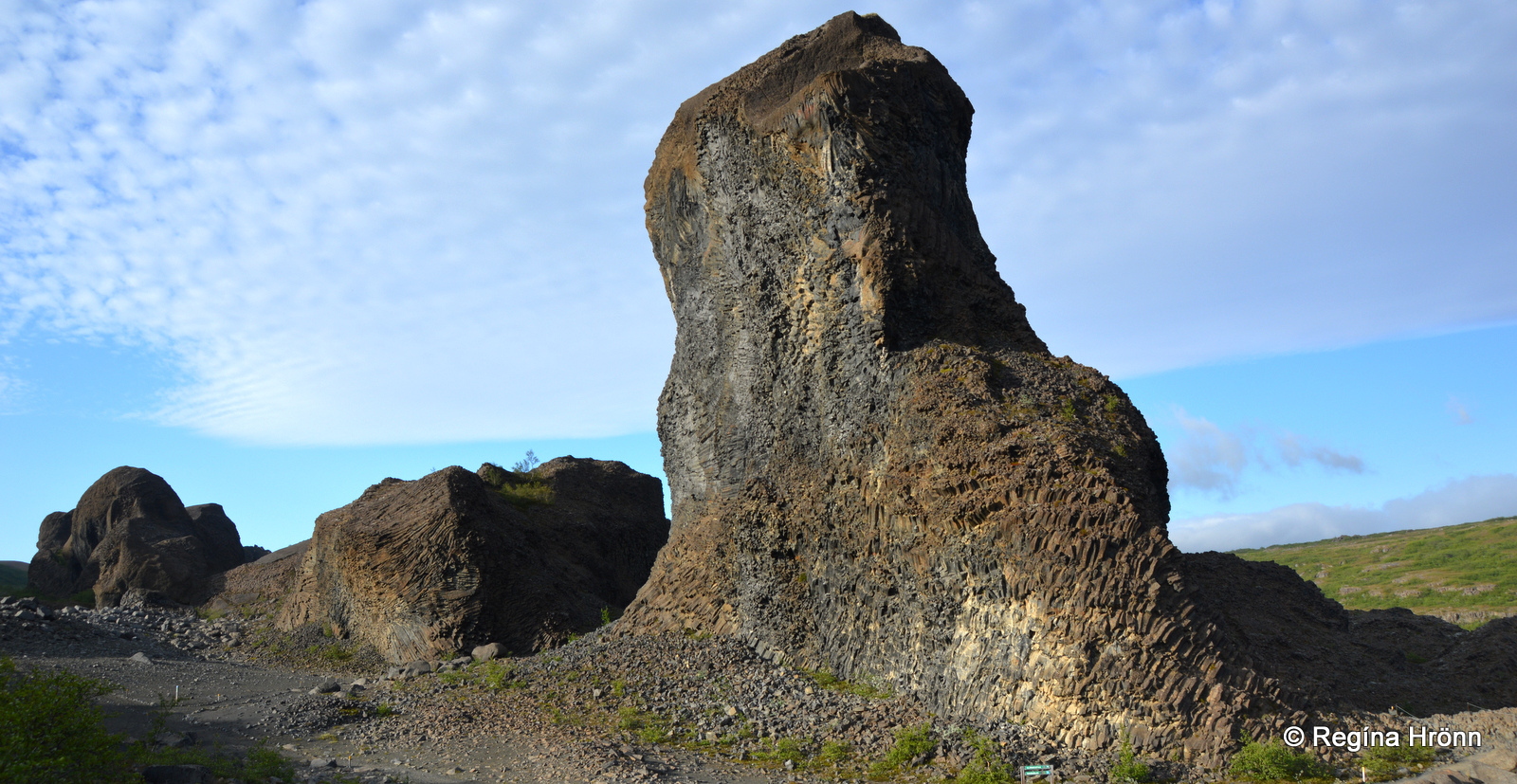
Tröllið – the Troll in Hljóðaklettar
Prominent in Hljóðaklettar is Tröllið – the Troll, but many rocks in Iceland go by this name. There are many old accounts in Icelandic folklore, which tell us about the encounters of the trolls with the inhabitants of Iceland.
According to our folklore then this troll in Hljóðaklettar got turned into stone when it got caught by surprise by the first rays of the sun.
But as is common knowledge here in Iceland then the night trolls cannot tolerate daylight 😉

Beautiful basalt column formations on the Troll
There are several hiking trails in Hljóðaklettar, the shortest one (0.5 hours) is only 1.2 km back and forth from the parking lot. That hike is easy and leads to the Troll only and back.
Turning to the right, closer to the glacial river, will lead to the east side of the Troll which is a very popular photo stop. Here you will see amazing basalt columns formations which look like works of art.

Strange formations on the Troll in Hljóðaklettar
Here the forms in the basalt rock take on the shape of rosettes and swirls and in between you will see honeycomb weathering, which I always find to be very interesting.
I have seen such honeycomb weathering in f.ex. Dimmuborgir at Mývatn, in the Westfjords and the Eastfjords.
Kirkjan – the Church in Hljóðaklettar

The Church in Hljóðaklettar as seen from above
Another hike is called the Hljóðaklettar circle and that one is longer (3 km the whole circle) and more demanding as it is a bit rocky but well worth the effort as the scenery is amazing.
This hike takes around 1.5 hours to complete. It also starts by the Troll, and then continues to the rock formation called Kirkjan or the Church.
The church is a beautiful cave, the biggest cave in Hljóðaklettar, in the shape of a symmetrical arch in one of the large rocks shaped in the form of a geologic dome.
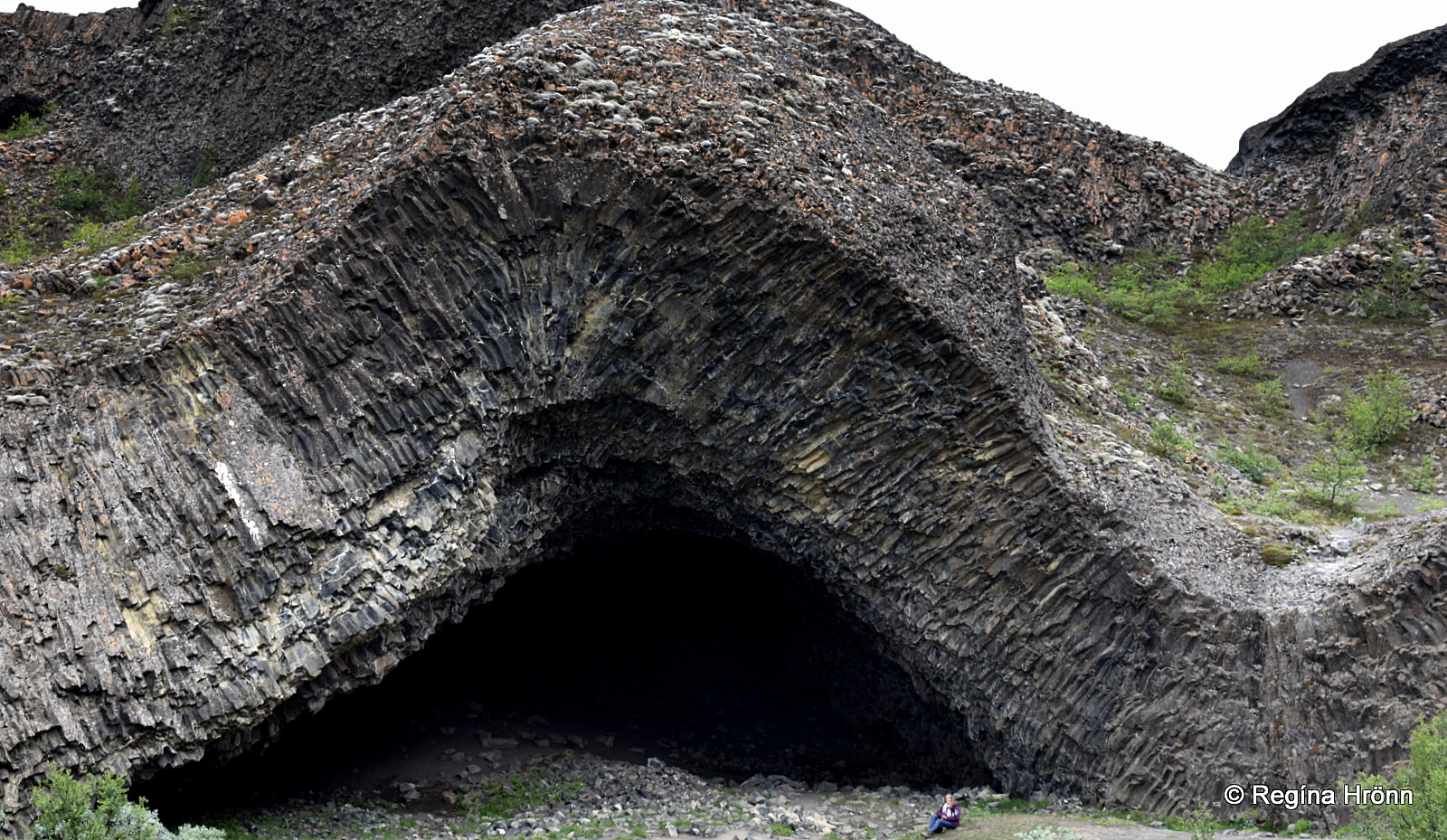
The Church in Hljóðaklettar
You can see how tiny I am compared to the Church in my photo above. You can enter the cave, but take care when entering the Church as we never know when rocks start falling from the ceiling.
Here you will find all kinds of basalt columns, diagonal, horizontal, and vertical. I must say that even though I have visited Hljóðaklettar many times I am always in awe when hiking in this area. I don’t think that it leaves anybody untouched visiting Hljóðaklettar.
You will see rock formations called Kirkjan – the Church in other places in Iceland, f.ex. in Dimmuborgir at Mývatn.
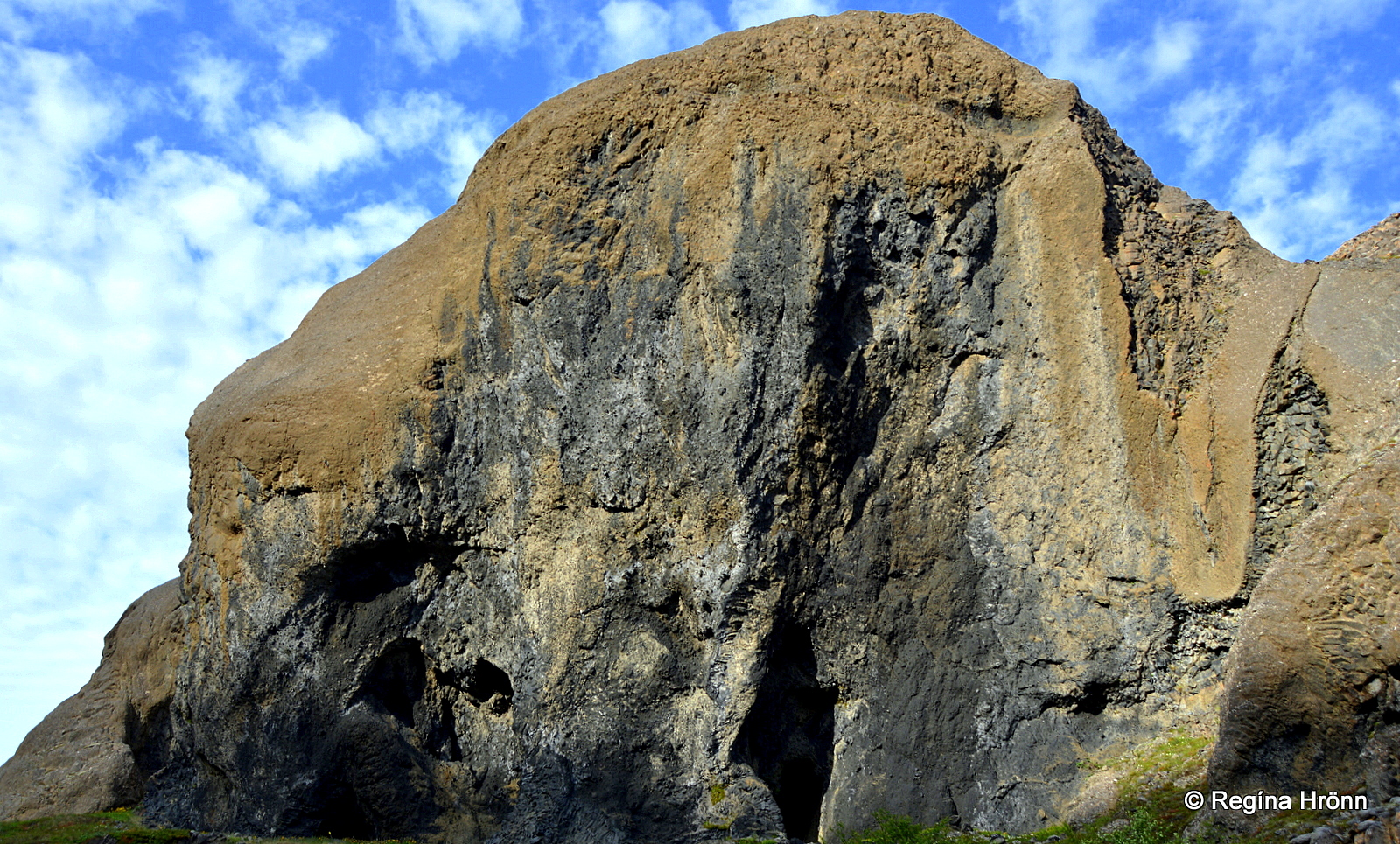
Skuggaklettur – the Shadow Rock in Hljóðaklettar
After visiting the Church you continue west (to the left) where stone steps lead to a trail behind the rocks. Here you will see strange rock formations and basalt columns in abundance.
One of the rocks is filled with small caves. It is called Skuggi or the Shadow Rock. True to its name the rock is somber and ominous looking and I always feel fear when visiting this area in the dusk and find myself standing next to Skuggi 😉
You can follow a trail to the caves and have a look inside.

Hiking in Hljóðaklettar
After you pass the Shadow Rock a short detour from the main trail will give you an opportunity to see what the Church looks like from above.
The circle ends by the Troll and from there a short walk will take you back to the parking lot.
Rauðhólar – Red hills
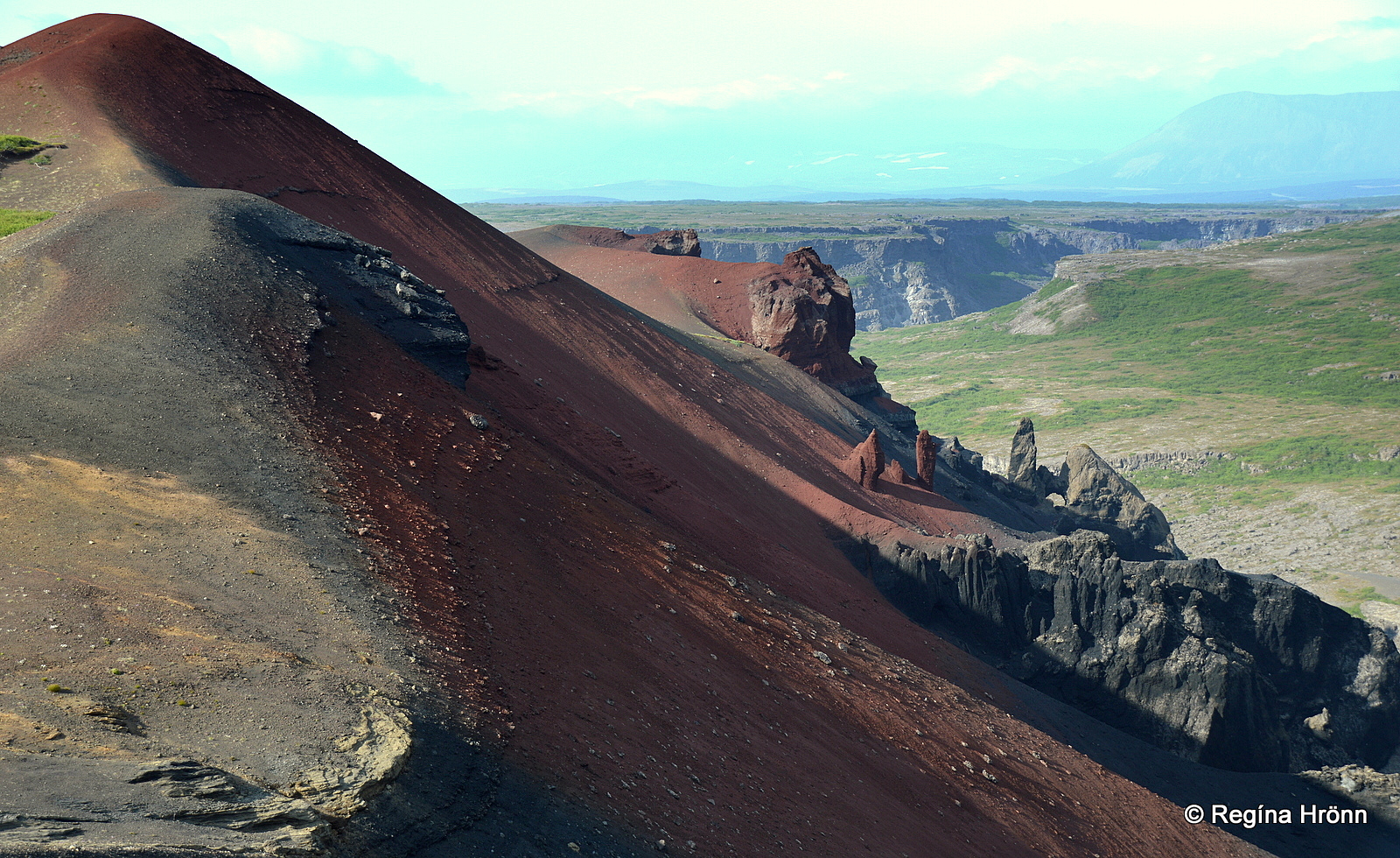
Rauðhólar – Red Hills scoria cones in Jökulsárgljúfur canyon
If you continue on the path from Hljóðaklettar further north you will reach Rauðhólar – Red Hills. Rauðhólar is a scoria cone with the most striking maroon color.
It is a 5 km circle from the parking lot that will take 1.5 – 2 hours to complete.
The scoria cone itself is off-limits as it has to be preserved, but you can get close enough to see f.ex. these two maroon pillars – volcanic plugs, which I find amazing. They look like they are from another planet.
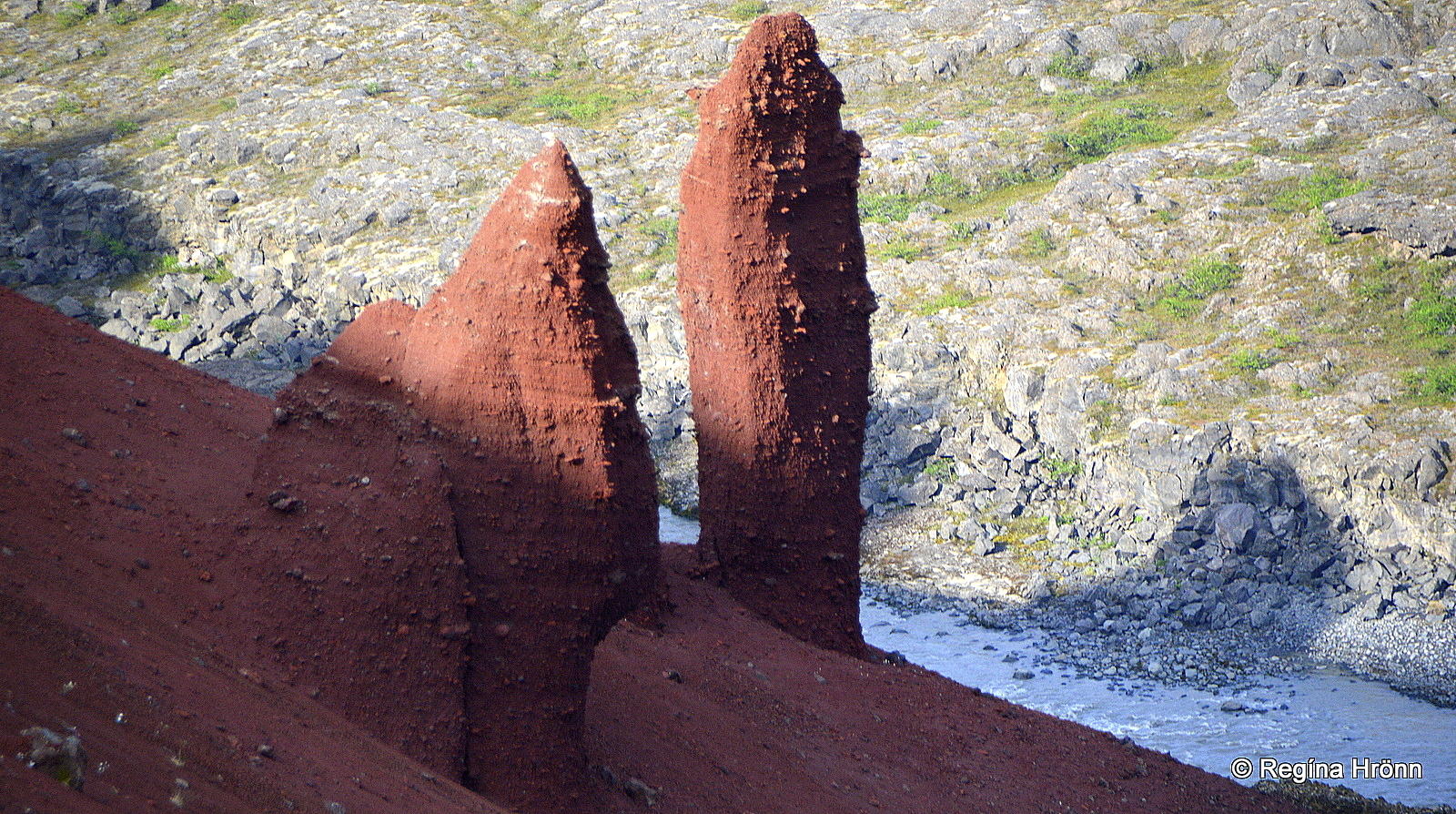
Two red pillars of rock by Rauðhólar – the Red Hills
At Rauðhólar you can see what the volcanic craters in Hljóðaklettar might have looked like before the volcanic material was washed away in the catastrophic flood.
From Rauðhólar you will have a fantastic view of Hljóðaklettar – in my opinion, they look like a fairytale city.
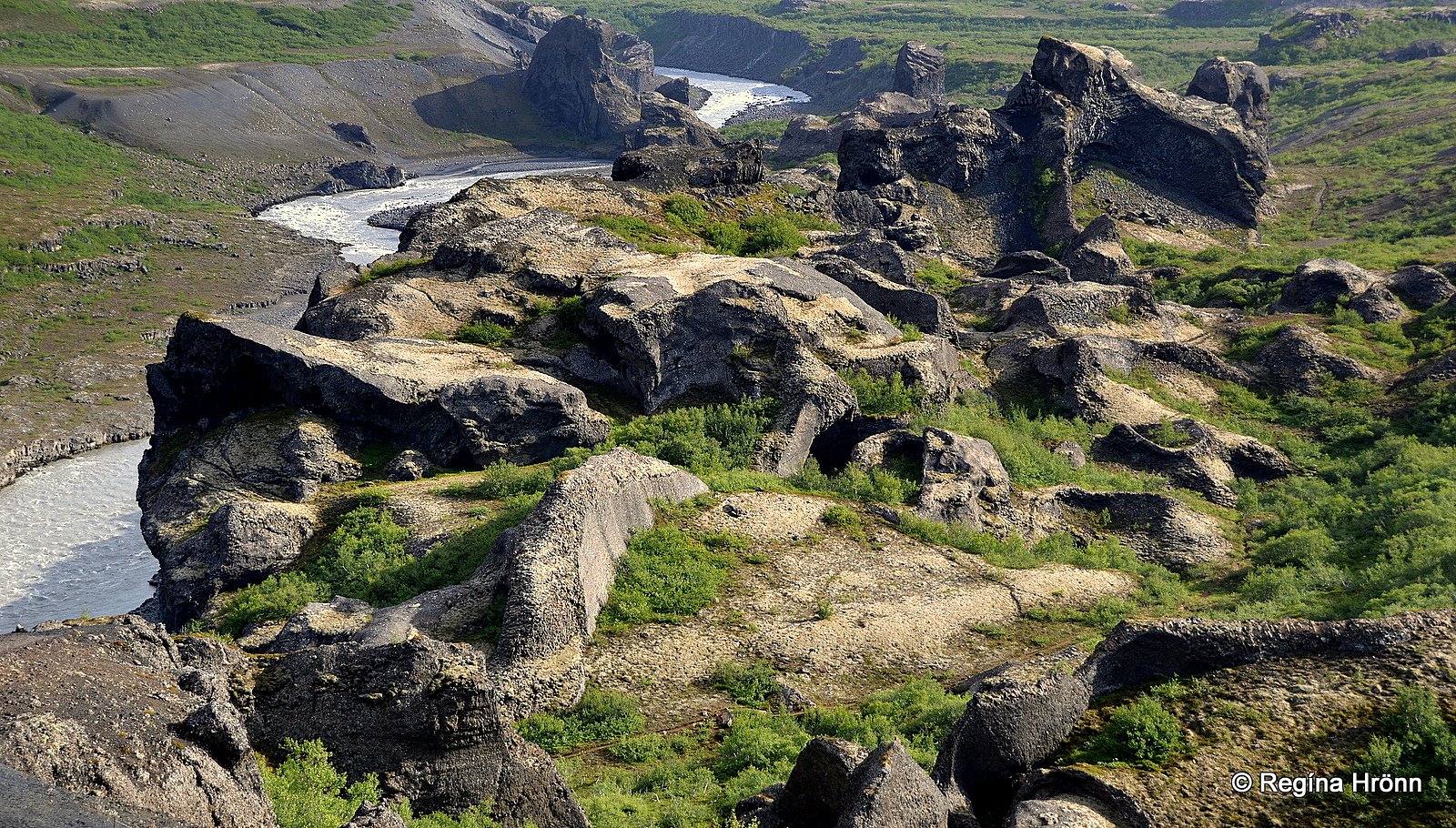
Hljóðaklettar as seen from Rauðhólar
Another good spot for a fantastic view of Hljóðaklettar from above is from Langavatnshöfði cape, but a new observation platform is being put up there.
Then you don’t drive down the steep hill into Vesturdalur and Hljóðaklettar but continue driving up to the cape.
I took a video from Rauðhólar:
Hljóðaklettar can be reached from road number 862 on the west side of the Jökulsárgljúfur canyon. Coming from ring road number 1 drive for approximately 39 km and make a right turn onto gravel road number 888.
Drive down a steep hill into Vesturdalur valley where you will see a camping area. Turn left and drive for a short distance in the direction of Jökulsá á Fjöllum glacial river until you reach the parking lot by Hljóðaklettar.
Road 862 was being paved in 2020 all the way to road 85.
Hljóðaklettar are a part of the popular Diamond Circle. In my next travel-blog I am going to show you another location on the Diamond Circle – Ásbyrgi – the Shelter of the Gods, which is my favorite place in Iceland.
Have a lovely time at Hljóðaklettar 🙂
